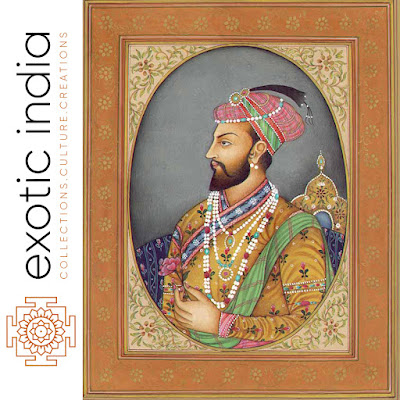Handmade Shah Jahan Watercolor Paper Painting
This ovally framed portrait is of the Mughal emperor Shahjahan,
the builder of the Tajmahal. He is the only one of the Great Mughals to have
lived to the greatest of grandeur and the worst of grief and achieved the
highest of glory and the lowest of gloom. This depiction closely represents his
likeness, as has been recorded in his contemporary portraits. The National
Museum, New Delhi, has in its collection a 1616-17 portrait of Shahjahan by
Nadir-al-Zaman-Abul Hasan, inscribed in Shah Jahan's hand, "A good
likeness of me in my 25th year". The portrait here save that it is a
bearded Shahjahan of later days and has a somewhat different styled turban - a
mix of Jehangari and his styles, has a close resemblance to his
authentic likeness. Shahjahan was a visionary, which his eyes, both in his
contemporary 1616-17 portrait and in this present one, reveal. The sharpness of
lines and overall delineation, which the time and chemical properties of colors
have adversely affected in the earlier portrait,
has been somewhat made up in this portrait.
He is presented here
with a sharply pointed nose, a well-trimmed mustache curving downwards,
thoughtful eyes, and prominently delineated ears with an upward thrust. These,
and the scarf on his shoulders, are characteristic features of most portraits
of Shahjahan. Rubies, emeralds, pearls, sapphires, and diamonds to some extent,
seem to have been his chosen stones. By assimilating all these features in his
portrayal, the artist has reached almost near his real likeness. Both the oval
mount and the rectangular frame are embellished with floral designs gorgeously
laid in gold, which constitutes a characteristic feature of the Mughal Art
style, post-Jehangir.
 |
| Shah Jahan Watercolor Painting |
Jehangir's third son
Khurram Shihab al-Din Muhammad, who ruled as Shahjahan from 1628 to 1657, was
born in 1592 to a Rajput queen of Jehangir from Marwar. When twenty, he was
married to Arjumand Banu Begum renamed later Mumtaz Mahal.
History bears testimony to Shahjahan's two passions, one for his wife Mumtaz
Mahal, and the other for architecture. The Tajmahal stands
as the highest monument of love. Built-in the memory of his beloved Mumtaz
Mahal, it combines both his infatuations - architecture and his mad yearnings
for Mumtaz, the companion of his struggles, woes, and miseries in his adverse
days.
Shahjahan had not only
led the Mughal Empire to greater geography but also far greater cultural
heights. But in an ironical twist of faith, this cultured and romantic Mughal
had to suffer during his last phase at the much uncultured and brutal hands of
his own orthodox and power greedy son, Aurangzeb.
Shahjahan passed away in humiliating captivity at Agra fort, in his creation,
the Musammam Burz, gazing at The Tajmahal with his fading vision, tossing his
restless head in the lap of his daughter Jahanara,
who had refused a part in her brother Aurangzeb's magnificent empire and had
preferred to serve her father in his last days.
Description by Dr.
Daljeet.
Dr. Daljeet is
Curator, National Museum of india, New Delhi.

Comments